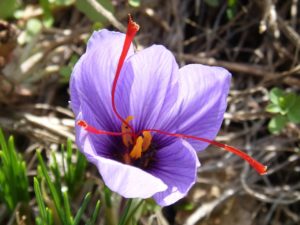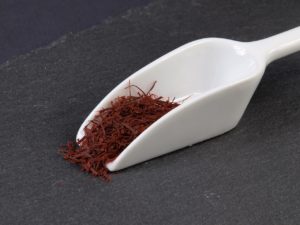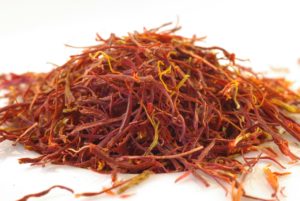Saffron for Moderate to Severe Depression
(and anxiety, Alzheimer’s and ADHD)
When thinking of herbs, I think most people think of St. John’s wort for depression. However, there is another herb that is starting to get attention and shows great promise.
While most of my research was on saffron for depression, saffron has been shown to be helpful for anxiety as well.
There is also new research that shows this herb to be helpful for those with ADHD.
What is Saffron
This is considered the most labor intensive herb to harvest and thus the reason for the high price for purchase. Because it is so expensive, beware of cheaper substitutes that may be passed off as the real thing. In an analysis of 151 samples of saffron, results showed that up to 90% contain one or more foreign substances.
The reason that it is so expensive is because it takes 150,000 flowers to produce 2.2 pounds of the yellow staining saffron spice which comes from the pistil, the orange-red stigma and styles in the center of the bloom. The pistils need to be removed and dried by hand and then are sold whole or in a powder that dissolves and turns bright yellow in water.
It is known in traditional Chinese medicine as fan hong hua, and prescribed for depression. The saffron tea is said to lift the spirits and calm the nerves.
The safranal, which is an essential oil in the plant, is said to me the main constituent that is effective for depression.
What the Research Shows
The recent interest in saffron for depression is due to some clinical research done in 2005 and 2006. The Hamilton Depression score was used to determine the subject’s level of depression. Double blind randomized trials were carried out. 2% safranal saffron extract was orally given in tablet form. This was in doses of 30 mg./divided, given 2 times daily. The first trial was small and compared the dose of saffron versus the placebo in 40 subjects. The effects were noticed within the first week and increased during the 6-week trial. The average Hamilton Depression score at the start was 23 and at the end it was 10. The placebo group averaged an improvement down to 18 on the Hamilton Depression score.
Saffron was then compared to imipramine (common name Tofranil) and fluoxetine. (Fluoxetine is the active ingredient in Prozac). Two randomized double blind trials were carried out over a period of 6 weeks with 30 subjects in the imipramine trial and 40 in the fluoxetine trial. In the imipramine study the subjects were given 100 mg. doses and in the other trial they were given 20 mg. daily. A significant improvement was noted again almost immediately after treatment with the saffron. There were no adverse side effects from those taking the saffron but in the subjects taking the drugs they noted sweating and dry mouth as common side effects.
Two more recent studies looking at the hydro-alcoholic extract of the saffron petals on those with mild depression. The first study was published in 2006. It was a double- blind placebo controlled trial conducted on 40 people over a 6 -week period. The petal extract was given in 30 mg. doses per day. Improvement in the saffron group was noted in the first week while no significant improvement was noted in the placebo group. During the 6 -week trial period the saffron petal extract proved to be significantly more effective than a placebo.
Another study using the petal extract was done in 2007. This study compared the petal extract once again to fluoxetine. The trial was conducted over an 8- week period with 40 people in the study who had Hamilton Depression scores that averaged at 22. 30 mg. of the petal extract and 20 mg. of the fluoxetine were administered in tablet form twice daily.
Again, the effects of the saffron were noted right away, within the first week. Scores dropped down to 10 in both groups. (anti-depressants usually take 6 weeks to take effect)
Saffron For ADHD
There is new research (2019) that shows saffron may be beneficial also for those with ADHD. The study was published in the Journal of Child and Adolescent Psychopharmacology and suggests that it can benefit children with ADD symptoms. In the study the children either received 30 mg. of saffron or Ritalin. Both groups showed promise.
This was a 6 week randomized double blind study with 54 children, ages 6-17 years old. Out of the 54 children, 50 completed the randomized double-blind study. Symptoms/improvement was assessed using the Teacher and Parent ADHD rating scale-IV at baseline and at weeks 3 and 6.
The one thing I cannot figure out (and I can only see the abstract where ideally you really need to read the entire study), is that it states that side effects were no different when comparing the two groups. Typically Ritalin comes with side effects such as sleep disturbances and loss of appetite as the more common and well-known drug effects. Saffron does not have these effects.
Either way, I think until they do studies that are longer and with more participants, this shows great promise and can be a useful remedy in place of a drug for ADHD.
My Thoughts on Saffron Use for Depression/Anxiety
Saffron appears to be better than a placebo and just as effective as fluoxetine but may act quicker and without any side effects. Saffron petal may be just as effective as the stigmas
These studies are not large but are promising. Saffron has been used and shown to be effective in those with moderate to severe depression and is fast acting. Saffron is also good for those with anxiety, stress and OCD. Often one or more of these other conditions coincide with depression.
Further research is needed with more test subjects than just 40 in a trial. However, effects were noted within the first week and improvements continued through the trials and without side effects.
I would like to know where the saffron was sourced from, which product brand they used since it can be challenging to find a reputable brand. I would also like to see more studies using the saffron petal as perhaps this can be just as effective as the stigma thus less costly.
Where to get Saffron
For me personally, I am still trying to locate a reputable source for the pistils and petals to make a tincture but until then I have been using the Life Extension capsule saffron.
- Saffr’ Activ ® is an extract derived from the red stigma of the saffron. (www.saffractiv.com) (cultivated in Iran, N. Africa and Greece) It comes in liquid and tablets. It is NOT available in the US. If you are outside the US and have used this brand or will try this brand, I would love to hear your results with the product.
- Other products are based on roughly 88.5 mg. tablets of saffron extract standardized to a minimum of .3% safranal (Vitacost, Biotrust, Swanson, Pure Formulas, Life Extension). These products are touted on weight loss and decreased snacking.
- Consumerlabs.com is a good site to use to check if a product has the ingredients is says it has on the label. For herbs, many generic products seem to not have what it says on the label. When in doubt, purchase a quality brand and not a big box store brand when it comes to herbs. (to look up supplement ingredients on consumer labs there is a yearly small fee)
- Know what parts of the herb are used: Saffron pistils and petals have shown to help depression in studies. When I researched products, some say they contain leaf and stem. This would be a waste of your money
Should you Try it?
First make sure you are using a product from a reputable source. When in doubt, call and ask questions. If they can’t or don’t respond to your questions, then it may be best to avoid that product. Always speak with your health care person prior to herb use as herbs can interact with some medications. (Although in my research it appears that saffron is safe to use with medications) Since saffron may increase serotonin, discuss its usage first with your doctor if you are currently taking an SSRI. (I could not find any warnings in regards to this, but best to play it safe). Based on what some research states, you may want to limit your intake to a short time of 26 weeks or less. Because these products are at a higher dose than what depression studies have used, you may want to try this instead-the Life Extension product is in a capsule. Open it up and take only one half in the morning and the other half at night, or start with even a lower milligram amount and take only 1/2 a capsule per day.
Beware of Imitation Saffron Products
While you may be purchasing your saffron in capsule form, here are some things you can look for if using whole pistils.
o There are several ways to tell if you have the real thing versus a fake product
- the pistil should have a trumpet shape at the end
- if the pistil is perfectly straight then it is a fake
- Smell it-it should have a woody aroma. A fake often has sandal wood added to it.
- Add it to water-the saffron will turn the water a golden sunny yellow color. The fake will turn it a more reddish color. The coloring is a gradual process for the real saffron and the coloring effect is immediate in the fake product.
- The fake threads will dissolve as you rub it between your fingers, the real saffron will not.
- The Kashmir saffron is the best quality. The Iranian saffron is shorter, a bit more brittle but still good to use.
- Fake saffron is often made with corn silk links and then dyed.
- Some powdered products are saffron mixed with more affordable herbs such as marigold and safflower.
When to Use Caution
- long term use may cause kidney damage and central nervous system damage (B. Mars, A.H.G in The Desktop Guide to Herbal Medicine and Hosseinzadeh, et. al.,)
- large doses may cause coughs or headache (B. Mars, A.H.G in The Desktop Guide to Herbal Medicine)
- Avoid during pregnancy and breastfeeding (B. Mars, A.H.G in The Desktop Guide to Herbal Medicine)
- Some do say that more than the 30 mg. per day and for long periods could be toxic and that 1200 mg. or more per day may cause nausea and vomiting. (long periods were defined as anywhere from 26 weeks to 6 months weeks) (examine.com; naturaldatabase.therapeuticresearch.com-this is a paid site)
- Others say that 1.5 grams per day and up to 5 grams per day is safe (livestrong.com)
- The only side effect that was noted in the Saffron studies was less snacking! This could be due to the elevated serotonin action in the body.
Overall it appears that saffron is safe to take for 8 to 26 weeks but after that it may do more harm than good. Just because it is an herb, not a medication, does not mean it is safe. Always use caution and seek the help of a professional when using herbs.
My Experience with Saffron
Before having my clients try a product I am not familiar with, I often like to use myself (or family) as guinea pigs. I purchased one bottle of the Life Extension product. I took one capsule two times per day until the bottle was finished. I missed several days of the second dose and two days did not take any over the course of supplementation.
I did notice an overall improved mood and a sense of calmness. Please note that I do not have moderate or severe depression but have had some stressful events recently that I can say have been impacting my mood. The saffron was supportive. I used to suffer from anxiety as a child and teen and what helped was changing my diet and balancing my blood sugar and hormones. However, I must admit I am still not the most mellow person in the world! What was interesting recently is that when my husband and I were talking about an upsetting event he said “I am sick to my stomach over this. Doesn’t it bother you? How can you be so calm?” My husband is usually not one for feeling overly anxious. Maybe I need to give him some saffron!
In addition to that, saffron is touted as a product to curb cravings. I did notice less of an appetite and did snack less mid-day and in the evening.
I contacted Life Extension to ask about their product. While their product bottle does say for positive mood enhancement, it also says it supports healthy eating habits. The company responded to my questions right away. The reason for the higher milligram dose is because they are basing it off a study using saffron to curb snacking, not studies looking at its use for depression which used a different dose. You can find the abstract to that study here. Their product uses Satiereal® which is derived from the stigmas of the saffron flower. Satiereal is a registered trademark product of INOREAL. Life Extension also provided to me a great deal of information of their standards in regards to quality and testing of their products. So, I trust their product and their other products as well.
I still have questions about the high dose of the Life Extension product and the possible contraindications if used for long periods of time. I believe this product can be helpful to use for short periods of time while you are focusing on other aspects to address your anxiety and depression.
Lastly, if you are anxious or depressed and have a reduced appetite, a product with a milligram dose higher than 15-30 mg. may not be for you. You don’t need to take a saffron product that will reduce your appetite even more. However, could the product reduce your anxiety and depression to the point that you would regain your appetite? If you try products with the higher milligram dose I would love to hear your results!
In the end, I feel that if you are struggling with a mental health issue, it is best to seek the support of a professional who can assist you to see if saffron (and if so, which saffron product) is right for you.
Bottom line
Keep in mind, an herb is not a magic pill. Herbs rather support the body and allow your body to do what it needs to do. My philosophy is to combine herbs with a diet that is right for your body. If you continue to consume a diet filled with refined, sugary, starchy, nutrient deficient foods, then you need to work on that. All the herbs (or supplements for that matter) in the world will not help you if you continue to put the wrong foods for you into your body.
If you are using saffron for a child, the dose should be adjusted according to their weight so work with a professional.
Sources:
Akhondzadeh, S. et. al., Comparison of Crocus sativas L. in the treatment of mild to moderate depression: a
double-blind, randomized and placebo controlled trial. Phytotherapy research, 19(2005)148-151
Akhondzadeh, S. et. al. Comparison of Crocus sativas L. and imipramine in the treatment of mild to moderate
depression: a pilot double-blind randomized pilot trial, BMC Complementary and Alternative Medicine, 4 (2004)
12-16.
Balch, P. Prescription for Herbal Healing. 2nd Edition NY: Avery
Basti, A.A. et. al. Comparison of petal of Crocus Sativus L. and fluoxetine in the treatment of depressed out-
patients: a pilot double-blind randomized trial. Progress in Neuro-Psychopharmacology & Biological Psychiatry,
31 (2007) 439-42.
Bauman, E. & Friedlander, J. (2013) Therapeutic Nutrition. Pengrove CA: Bauman College
Boon, H. & Smith, M. (2009) 55 Most Common Medicinal Herbs. Second edition. Canada: Robert Rose Inc.
Gladstar, R. (2012) Rosemary Gladstar’s Medicinal Herbs. A beginners Guide. MA: Storey
Publishing.
Gleen, L. (2/28/06) Saffron: Crocus sativas. cms.herbalgram.org
Gregor, M. (10/19/12) Saffron vs. Prozac. http://nutritionfacts.org/video/saffron-vs-prozac/
Gregor, M. (10/18/12) Wake up and smell the Saffron.
http://nutritionfacts.org/video/wake-up-and-smell-the-saffron/
Hoffman, D. (2003) Medical Herbalism. The Science and Practice of Herbal Medicine. VT:
Healing Arts Press.
Hosseinzadeh, et. al. Acute and Sub acute Toxicity of Safranal, a Constituent of Saffron in mice and rats. https://www.ncbi.nlm.nih.gov/pmc/articles/PMC3813202/
Mars, B.(2007) The Desktop Guide to Herbal Medicine. CA: Basic Health Publications, Inc.
Moshiri, E. et. al. Crocus sativas L. (petal) in the treatment of mild to moderate depression: a double-blind,
randomized and placebo controlled trial. Phytomedicine, 13 (2006) 607-11.
Noorbala, A.A. et. al. Hydro-alcoholic extract of Crocus sativas L versus fluoexetine in the treatment of mild to
moderate depression: a double-blind, randomized pilot trial. Journal of Ethnopharmacology, 97 (2005) 281-84.
Phillips, B. (2006) The Book of Herbs. Utah: Hobble Creek Press
Schar, J. (2/12)A taste of good cheer: Saffron for treatment of Cancer related depression. www.naturopath.com/
saffron.html
Uddin, R. (9/23/15) Saffron Poisoning. http://www.livestrong.com/article/255826-the-benefits-of-saffron-root
___(nd) Saffron. https://examine.com/supplements/saffron/
https://www.psychologytoday.com/intl/blog/integrative-mental-health-care/201904/saffron-promising-herbal-treatment-adhd
https://www.ncbi.nim.nih.gov/pubmed/30741567
If you are sick and tired of feeling sick, tired, fatigued, depressed, anxious and more and have given up hope then Karen’s simple, effective, individualized and sustainable approach may be what you need.
Karen Brennan, MSW, CNC, Board Certified in Holistic Nutrition and Herbalist is the author of Tru Foods Depression Free Nutrition Guide; How Food Supplements and herbs can be used to lift your mood and owner of Tru Foods Nutrition Services, LLC.
For more information visit www.trufoodsnutrition.com
Get her Food Swap Guide here to get started on your health journey today! Want more information, like her fb page here
As a nutrition professional, Karen does not treat, cure nor diagnose. This information is for educational purposes only.
Karen Brennan, MSW, CNC, Herbalist
Board Certified in Holistic Nutrition®
Tru Foods Nutrition Services, LLC
303-522-0381





Paradise Herbs has a proper 15 mg. dose capsule. It is available all over the internet and in many health food stores
Thank you. I did not know that. I am not familiar with the Paradise brand, its quality and reputation so I will have to look more into it. Steve, have you used this product and if you don’t mind sharing if it benefited you or not.